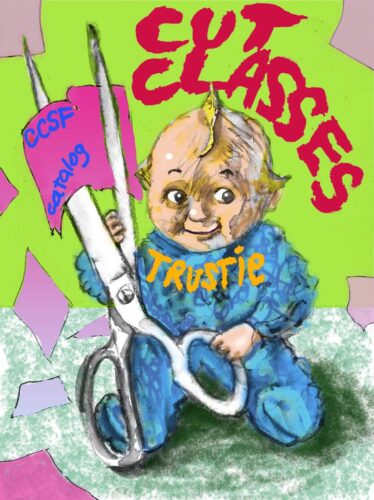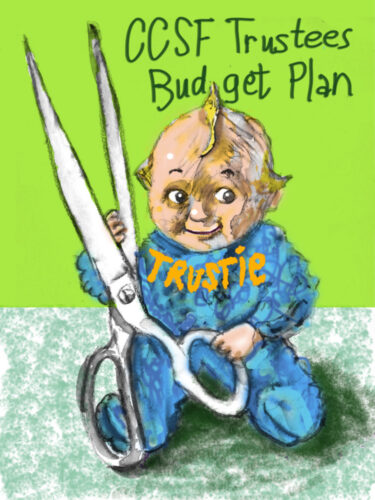A Many-Faceted Financial Fiasco
By Annette Mullaney
City College continues to face a structural budget deficit due to declining enrollment, changes in funding, and financial mismanagement, and plans to drastically cut classes and staff in the coming years.
To help make ends meet this year, the College is borrowing $10 million from its Other Post-Employment Benefits (OPEB) fund, monies the College is required by law to set aside as a guarantee for future retiree benefits such as healthcare. The College also borrowed from the fund for fiscal year 2019-20, using $21 million of the $28 million in the fund, which it has 21 years to pay back.

Business department faculty Carol Meagher said, “It’s not a bad idea in the short term, but it’s not sustainable.”
For the longer term, the current administration is planning substantial reductions to classes, faculty, administrators, and staff, including at least 600 course sections cut for fiscal year 2021-22, as outlined in the Multi-Year Budget and Enrollment Plan approved at the Nov. 12 Board of Trustees meeting.
These cuts are necessary for the college’s financial solvency, proponents argued, which is needed to keep accreditation. In September, the Accrediting Commission for Community and Junior Colleges (ACCJC) placed City College under enhanced monitoring due to its financial instability, requiring a response by early December. The multi-year plan was cited in the College’s response.
“We have a structural budget deficit,” said Vice Chancellor of Finance and Administration John al-Amin. “This didn’t occur in 2020. This occurred over a series of years.”
The COVID-19 pandemic has exacerbated the college’s financial woes, with decreased tax revenues and delayed funding from the state, but it is not the genesis of the problem.
American Federation of Teachers 2121 President Malaika Finkelstein said, “We’re in the context of chronic underfunding of public schools all over the country.”

She added that the state, which provides 56% of the college’s budget in fiscal year 2020-21, is explicitly moving away from serving nontraditional and noncredit students. The Student Centered Funding Formula (SCFF) bases more funding on students’ attainment of certificates, degrees, and job placements.
“The state does not have the same priorities as San Francisco,” said Enrollment Management Committee Co-Chair Wynd Kaufman “They are not funding us as a community college.”
Finkelstein said that AFT 2121 is currently talking with the state-wide union about lobbying for changes in the funding formula. “The formula has changed many times; it’s going to change again.” She added that the union is currently looking at going alone, as “our own administration has flat-out refused to discuss [lobbying].”
Deputy Chancellor Diana Gonzales and Director of Media Rosie Zepeda did not respond to requests for interviews for this article.
There is some hope for more funding from the City of San Francisco. On Nov. 25 Mayor London Breed approved the creation of a Workforce Education and Recovery Fund, which will provide $200,000 for the spring semester.
Proposed by Supervisor Gordan Mar in March, this fund was originally to provide $20 million per year, but was scaled back during the pandemic. According to Finkelstein, more money could go into this fund as the City’s revenues recover.
City College also has to make any funding stretch further than most schools. State funding is primarily based on the number of students, and is the same across the state, without accounting for differences in cost of living. “It’s a San Francisco cost of living on a Sacramento salary,” said Meagher.
The college has further been hit by a massive decline in enrollment, larger than that experienced by community colleges across the state. While classes have been cut significantly, over 800 since Fall 2018, the college has a lot of fixed costs that do not scale with decreased enrollment.
Furthermore, many believe that cuts have not been sufficiently targeted. According to business department instructor Michael Needham, there has been a shift away from departments that do not result in student success metrics under the state’s new funding formula, even if they have good productivity. He also pointed out that the success metrics only account for 1.9% of total revenues.
The shift in focus has particularly hurt programs for older adults and ESL, which according to Finkelstein is a “cash cow” for the college.
Some faculty feel that the cuts are made without sufficient analysis of the associated costs and revenues. “They don’t have a very sophisticated way that they are doing enrollment numbers,” Kaufman said.
These cuts further depress enrollment, necessitating more cuts, in what Finkelstein described as a “spiral.”
These challenges have been exacerbated by what Needham called “years of fiscal mismanagement.” He said that while administrators are well-intentioned, “this [administrative] entity is completely unable to plan from a finance perspective.”
Needham added that the difficulty of long-term planning has been compounded by high leadership turnover. “It’s been eight years with a revolving door administration.”
“There were mistakes made by past administrations,” said John Rizzo, veteran member of the Board of Trustees. He pointed to last year, when the board passed a balanced budget in September, only for then-Chancellor Mark Rocha to announce a $13 million deficit in November, leading to the “Midnight Massacre” when 345 classes were cut the day before Spring 2020 registration.
“That was some kind of error,” Rizzo said. “We’re still not sure what happened.”
“We’ve put balanced budgets together every year and barely start, and we’re in a hole,” said SEIU Local 1021 President Athena Steff.
Many have pointed to a lack of financial monitoring. At the Budget Committee meeting Dec. 8, Al-Amin said, “I’ve noticed that at least for the budget group, you haven’t been presented with monthly or quarterly financial reports.” He promised that his office will prepare “routine, regular monthly reports that the [Budget Committee] can review, question, and more importantly, see where the expenditures are.”
Al-Amin, who began Nov. 10, is one of two administrators recently hired to help improve financial management. David James began Dec. 1 as executive internal auditor and controller.
The Academic Senate, the Full-Time Caucus, and members of the Board of Trustees have been among those requesting an independent auditor for years. “I’m hoping he’ll keep track of spending as it’s going on during the school year,” Rizzo said. “It’s been a chronic issue.”
James’ first two tasks will be determining the total cost of administrators and consultants, with reports expected sometime in February. A 100% overspend on consultants in the first three months of the fiscal year were one of the reasons cited by the Full-Time Caucus in their Jan. 15, 2020 open letter to the Board of Trustees requesting an auditor.
James said the approval of his hiring at the last board meeting was encouraging. “They took the time to specifically discuss the position, how they supported it, how they thought it was needed in this time of fiscal crisis.”
